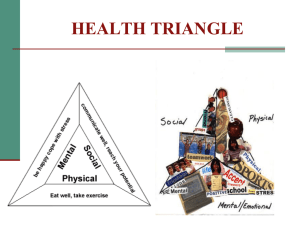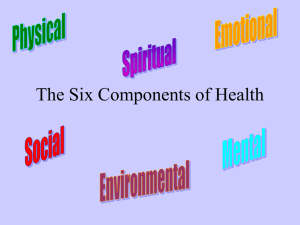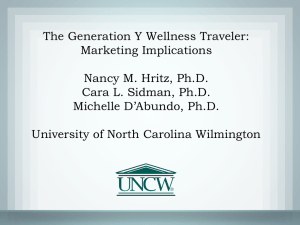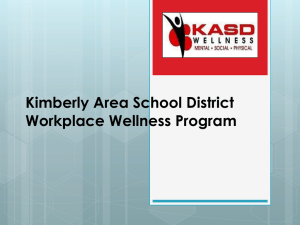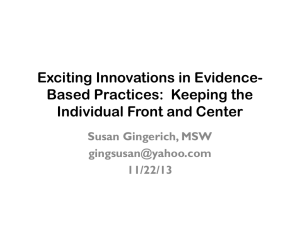Resident Evaluation of a Web-based Integrative Medicine Curriculum
advertisement
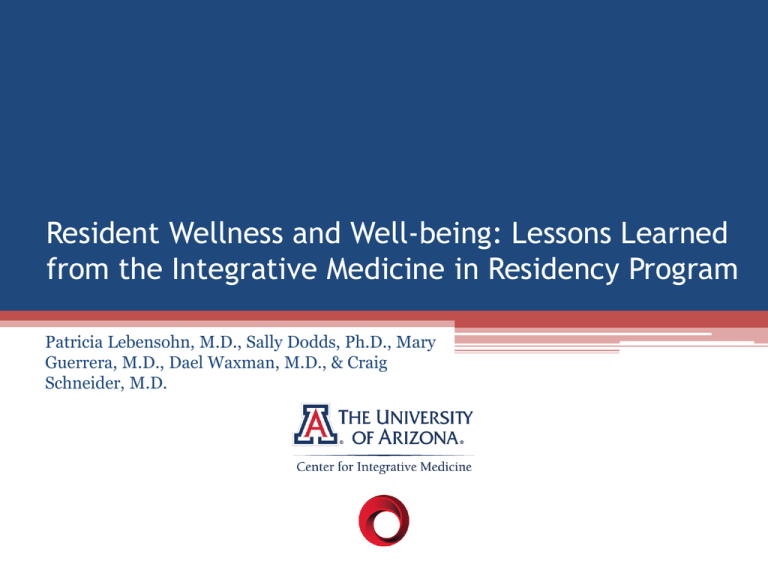
Resident Wellness and Well-being: Lessons Learned from the Integrative Medicine in Residency Program Patricia Lebensohn, M.D., Sally Dodds, Ph.D., Mary Guerrera, M.D., Dael Waxman, M.D., & Craig Schneider, M.D. Presentation Objectives ▫ Describe the importance of teaching about wellness and well-being during residency. ▫ Discuss the definitions of wellness and well-being used in the IMR. ▫ Describe the tools used to assess resident wellness and well-being. ▫ Review the preliminary findings about IMR resident wellness and well-being. ▫ Discuss teaching strategies to promote IMR resident wellness & wellbeing. Integrative Medicine in Residency (IMR) is… • Competency-based, online, 200-hour, curriculum. • In-depth training in Integrative Medicine. • Incorporated through all 3 years of Family Medicine residency. • Piloted at 8 residencies nationwide. • Seamless, online evaluation of the curriculum and the residents. • Responds to ACGME competency requirements. • Evaluation developed simultaneously with the curriculum. Alaska Family Medicine IMR Program Locations Maine-Dartmouth Univ. of Minn Hennepin County Maine Medical Center University of Connecticut A. Einstein Montefiore Beth Israel Carolinas Medical Center Moses H. Cone University of Arizona University of Texas Medical Branch Control sites Importance of Teaching About Wellness & Well-being Residency is a powerful, formative experience in adulthood. Establishing physician identity, schema of patient relationships, work habits, and self care. Physician Burnout Estimates of physician burnout: 25% - 70%. Onset linked to residency training. Distress in Residency Dramatic increases in depression, anxiety, and drug use. Increased cynicism, decreased empathy, poorer overall performance. Consequences Psychological problems under diagnosed and under treated. Physician stress and burnout linked to lower-quality patient care. Habit of ignoring self care perpetuated in life after residency. IMR and Wellness & Well-being IMR uniquely positioned to shift graduate medical education toward physician wellness. Prevention and wellness are central in course content. Opportunity to explore and describe resident wellness & well-being longitudinally. IMR Wellness & Well-being Definitions Wellness behaviors: Specific behaviors and lifestyles that promote optimal physical, psychological, and spiritual health (Carlson et al., 1997). Sense of Well-being (multiple dimensions): Satisfaction with Life: Global judgment of quality of life (Diener et al., 1985). Sense of Happiness: Pleasant affects (Pavot & Diener, 2008). Psychological well-being: Absence of psychological distress (Ryff et al., 1995; Keyes et al., 2002). Positive Personal Characteristics: Qualities of mindfulness, a grateful disposition, and emotional intelligence in the context of interpersonal relationships. Wellness Behaviors Assessed in the IMR Behavior Behavior Moderate physical activity (30 min/da) Massage Fruits & vegetables (5/da) Outdoors in nature Vitamins/other dietary supplements Nurturing relationships Meditation Restful sleep Prayer Alcoholic drinks per week PMR/other relaxation Smoking (y/n) Yoga Rx for mood, anxiety, stress, sleep (y/n) Tai Chi or Qi Gong Resident Wellness Behaviors (All groups combined) Protective 70% 60% 50% 40% 30% 20% 10% 0% Phys Act Fruit/Veg Nurt Rels None 1-2 PMR 3-4 5-6 Meditation Daily Prayer Resident Wellness Behaviors (All groups combined) Risk 34% 38% 35% 45% 17% 13% 11% 5% 3% Restful sleep None 1-2 da 3-4 da Alcohol drinks per week 5-6 da Daily 0 1-3 4-7 8-14 14+ Rx Dep/Anx/Stress Smoke Yes 14% Yes 2% No 98% 0% No 86% Well-being Measures Dimension Measure Global life satisfaction Satisfaction with Life Scale (SWLS; Dierner, 1985) Affective traits Positive & Negative Affect Schedule (PANAS; Watson, 1988) Psychological health Perceived stress Mood state distress Depression Burnout Personal characteristics Mindfulness Gratitude Emotional intelligence Perceived Stress Scale (Cohen et al., 1983) CES-D (Radloff, 1977) PHQ-9; (Kroneke et al., 2001) Maslach Burnout Inventory (Maslach et al. 1996) Freiburg Mindfulness Inventory (Walach, et al., 2006) Gratitude Questionnaire-6 (McCullough, 2002) Trait Meta Mood Scale (Salovey & Mayer, 1995) Interpersonal Reactivity Index (Davis, 1980) Perceived Stress Scale (e.g., “How often you felt you were on top of things?”) Mean scores at baseline – 2011, 2012, Controls 2011 15.7 Range 1-33 ns 2012 Controls 16.9 16.1 Range 5-27 Range 9-30 Possible scores range from 0 – 40. Perceived Stress Scale Frequency of stress in the past month (at baseline) 2011 2012 Controls 61% 58% 59% * 27% 26% 22% 15% 15% 15% 2% Never (<10) *p = .03 Almost never (11-20) Sometimes (21-30) Fairly often /Often (>31) Perceived Stress Scale Baseline and 1st repeated measure 2011 Class (mean scores) PGY1 Stress Frequency past 30 days PGY2 PGY1 PGY2 75% *61% 15.4 16.9 23% **14% 14% 9% Never Mean Score n=44; ns 2% 2% Almost never (11-20) * p = .002; ** p = .001 Sometimes Fairly often (21-30) /Often (>31) CES-D (Depression screener) – Mean scores PGY1 – All groups (baseline) 2011 2012 Controls 12.5 11.4 Range 0-34 ns Range 0-32 Cutpoint =/> 16 11.5 Range 1-34 CES-D Severity scores in the past month (at baseline) 2011 67% 2012 Controls 74% 72% 17% 16% Non depressed <15 12% Mild depression 16-20 10% 9% 12% Moderate depression 21-30 5% 2% 4% Very depressed >31 CES-D Baseline and 1st repeated measure 2011 Class means PGY1 PGY2 Severity scores 76%* PGY1 PGY2 67% 12.2 10.9 Range 0-34 Range 0-32 n=46; ns Mean Score 17% 9% Non depressed <15 *p= <.001 11% 13% Mild Moderate depression depression 16-20 21-30 4%2% Very depressed >31 PHQ-9 (Depression diagnostic screener) Mean scores at baseline 2011 (02) 2012 3.8 Controls 4.2 3.3 Range 0-13 ns Range 0-14 Range 0-16 PHQ-9 Severity scores at baseline 2011 (02) 71% Controls 64% 65% 25% 28% 27% 4% ns 2012 None (<4) Mild (5-9) 8% 4% Moderate (10-14) 4% Mod Severe (15-19) Severe (>20) CES-D and PHQ-9 Compared 2011 PGY2 CES-D (02) PHQ-9 (02) 76% 71% 25% 9% Non dep/None Mild 13% 4% Moderate 2% 0% Mod severe/ Severe Maslach Burnout Inventory1 Emotional Exhaustion Subscale (e.g., “I feel emotionally drained from my work”) Mean scores at baseline – 2011, 2012, Controls 2011 15.3 Range 1-33 ns 2012 16.9 Range 5-27 Mean Scores Controls 20.7 Range 9-30 Possible scores range from 0 – 54. Maslach Burnout Inventory2 EE category scores at baseline 2011 2012 Controls 71% 57% 54% * 32% 27% 18% 11% Low *p = .02 </=18 Moderate 19-26 High 19% 11% >/=27 Maslach Burnout Inventory3 EE Baseline and 1st repeated measure Mean group scores at baseline PGY1 Severity scores t1 – t2 PGY2 PGY1 PGY2 71% 45% 39% ** * 22.3 16% * 10% 15.3 Low </=18 *p=<.001 ns *p=.032; **p=<.001 Moderate 19-26 18% High >/=27 Maslach Burnout Inventory4 Depersonalization (e.g., “I really don’t care what happens to some patients”) Mean scores at baseline – 2011, 2012, Controls 2011 ns 2012 6 6.5 Range 0-23 Range 0-18 Controls 8 Range 1-20 Possible scores range from 0 – 30. Maslach Burnout Inventory5 Dp Score Categories – 2011, 2012, Controls 2011 2012 Controls 61% 43% 38% 33% 27% 30% 35% 24% 9% Low <=5 Moderate 6-9 High >/=10 Maslach Burnout Inventory3 Depersonalization (Baseline &1st F/U) Baseline Severity scores t1 – t2 Baseline Time 2 PGY1 PGY2 59% * 53%*** 27%** 20% 6.2 10.2 8% Low <=5 p = <.001 33% Moderate 6-9 p = <.001 *p = <.001; **p=..001; ***p= <.001 High >/=10 References • • • • • De Matteo, MR, Sherbourne, CD, Hays, RD, Ordway, L, Kravitz, RL, McGlynn, EA, et al. (1993). Physicians’ characteristics influence patients’ adherence to medical treatment: Results from the Medical Outcomes Study. Health Psychology, 12, 2, 93-102. Eckleberry-Hunt, J, Lick, D, Boura, J, Hunt, R, Balasubramaniam, M, Mulhem, E, & Fisher, C. (2009). An exploratory study of resident burnout and wellness. Academic Medicine, 84, 2, 269-277. Eckleberry-Hunt, J, Van Dyke, A, Lick, D, & Tucciarone, J. (2009). Changing the conversation from burnout to wellness: Physician well-being in residency training programs. Journal of Graduate Medical Education, DOI:10-4300/JGME-D-9000026.1. Gunderson, L. (2001). Physician burnout. Annals of Internal Medicine, 135, 2, 145-148. Wallace, JE & Lemaire, J. (2009). Physician well being and quality of patient care: An exploratory study of the missing link. Psychology, Health & Medicine, 14, 5, 545-552. Discussion Acknowledgements University of Arizona Pilot Sites Emily Sherbrooke Ben Kligler, M.D., MPH Paula Cook Victor Sierpina, M.D. Rhonda Hallquist Selma Sroka, M.D. Tieraona Low Dog, M.D. Raymond Teets, M.D. Victoria Maizes, M.D. John Woytowicz, M.D.



